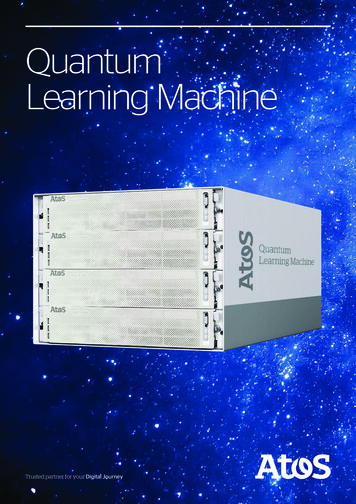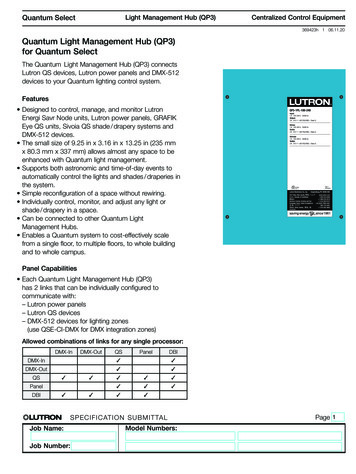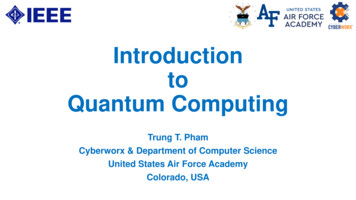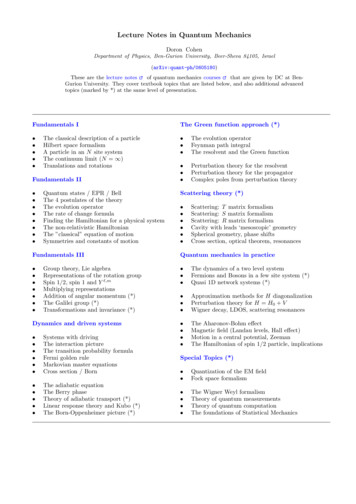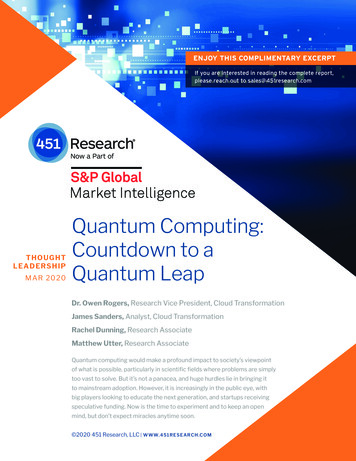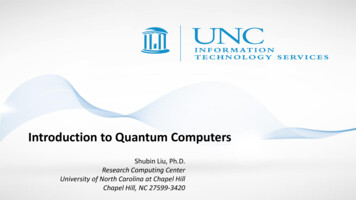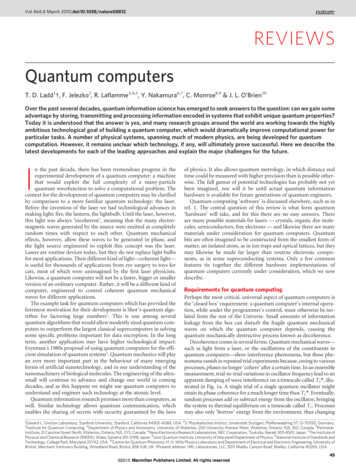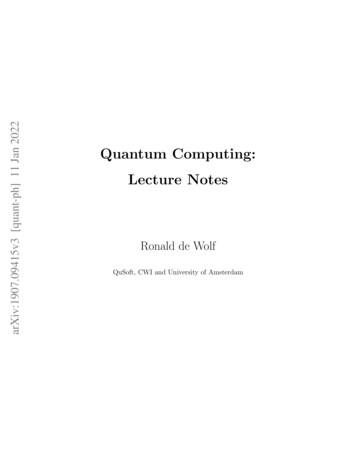
Transcription
arXiv:1907.09415v3 [quant-ph] 11 Jan 2022Quantum Computing:Lecture NotesRonald de WolfQuSoft, CWI and University of Amsterdam
Dedicated to the memory of my fatherAbraham de Wolf (1942–2019)ii
Preface from 2011These lecture notes were formed in small chunks during my “Quantum computing” course at theUniversity of Amsterdam, Feb-May 2011, and compiled into one text thereafter. Each chapterwas covered in a lecture of 2 45 minutes, with an additional 45-minute lecture for exercises andhomework. The first half of the course (Chapters 1–7) covers quantum algorithms, the second halfcovers quantum complexity (Chapters 8–9), stuff involving Alice and Bob (Chapters 10–13), anderror-correction (Chapter 14). A 15th lecture about physical implementations and general outlookwas more sketchy, and I didn’t write lecture notes for it.These chapters may also be read as a general introduction to the area of quantum computationand information from the perspective of a theoretical computer scientist. While I made an effortto make the text self-contained and consistent, it may still be somewhat rough around the edges; Ihope to continue polishing and adding to it. Comments & constructive criticism are very welcome,and can be sent to rdewolf@cwi.nlThose who want to read more (much more. . . ): see the book by Nielsen and Chuang [147] forthe general area, the book of John Watrous [180] for quantum information theory, and the lecturenotes of John Preskill [149] for the theoretical physics perspective.Attribution, acknowledgments, subsequent updatesMost of the material in Chapters 1–6 [chapter numbers in this paragraph are for the 2011 version]comes from the first chapter of my PhD thesis [181], with a number of additions: the lower bound forSimon, the Fourier transform, the geometric explanation of Grover. Chapter 7 is newly written forthese notes, inspired by Santha’s survey [156]. Chapters 8 and 9 are largely new as well. Section 3of Chapter 8, and most of Chapter 10 are taken (with many changes) from my “quantum proofs”survey paper with Andy Drucker [70]. Chapters 11 and 12 are partly taken from my non-localitysurvey with Harry Buhrman, Richard Cleve, and Serge Massar [46]. Chapters 13 and 14 are new.Thanks to Giannicola Scarpa (the teaching assistant for the first two editions of this course) foruseful comments on some of the chapters.January’13 : Updated and corrected a few things for the Feb-Mar 2013 version of this course, andincluded exercises for each chapter. Thanks to Harry Buhrman, Florian Speelman, and JeroenZuiddam for spotting some typos in the earlier version.April’13 : More updates, clarifications and corrections; moved some material from Chapter 2 to 1;changed and added some exercises. Thanks to Jouke Witteveen for useful comments.April’14 : Fixed and clarified a few more things. Thanks to Maarten Wegewijs for spotting a typoin Chapter 4.March’15 : Updated a few small things.July’15 : Updated and corrected a few small things, added more exercises. Thanks to SrinivasanArunachalam, Carla Groenland, and Koen Groenland for useful comments.May’16 : A few more corrections, thanks to Ralph Bottesch for useful comments.January’18 : Many more corrections, more exercises, a new Chapter 6 about the Hidden Subgroupiii
Problem (the above-mentioned chapter numbers are for the earlier version of the notes), and movedthe hints about exercises to an Appendix for students who want to try the exercises first withouthints. Thanks to Joran van Apeldoorn, Srinivasan Arunachalam, Rens Baardman, Alexander Belov,Koen de Boer, Daniel Chernowitz, András Gilyén, Ronald de Haan, Leon Ingelse, Stacey Jeffery,Rafael Kiesel, Jens Klooster, Sam Kuypers, Christian Nesenberend, and Christian Schaffner foruseful comments.January’19 : More corrections, clarifications and exercises, and new chapters about Hamiltoniansimulation (Chapter 9) and the HHL algorithm (Chapter 10). These two chapters can be taughttogether in two lectures, with the longer Chapter 9 spilling over into the second lecture if necessary.I marked by ‘(H)’ the exercises having a hint in Appendix C, and removed citations from exercises toprevent students looking up the original papers when doing the exercises (which is neither necessarynor helpful). Those references are [29, 66, 72, 42, 71, 82, 49, 23, 30, 21, 85, 57, 12]. Thanks toArjan Cornelissen, Sven Cornets de Groot, Gerrit Vos, and Harm de Vries for useful comments,and to András Gilyén for much help with Chapters 9 and 10. Thanks to my father and Mieke Beerfor hosting me for two months while I was recovering from an ankle fracture in a wheelchair, fromwhich much of these two chapters was written.July’19 : More corrections, clarifications and exercises. Thanks to Joran van Apeldoorn, AndrásGilyén, Stephanie Gonzalez, Sander Gribling, Jaco ter Hoeve, Arnold Kole, Lotte Mertens, StefanoPironio, Merel Schalkers, Jim Skulte, Iris Smit, Manuel Van, and Sebastian Zur for useful comments.Thanks to Barbara Terhal for suggesting the possibility of dedicating these notes.January’21 : More corrections, clarifications and exercises, and a new chapter about QMA and thelocal Hamiltonian problem (Chapter 13). Thanks to Dorit Aharonov, Tomas Ehrencron, Alex Grilo,Joris Kattemölle, Stan de Lange, Noah Linden, Tessel Majtlis, Nikhil Mande, Andrea Mazzocco,Robert Modderman, Thomas Preu, Philip Verduyn Lunel, Baer Ververgaert, and Carel Wagenaarfor useful comments.January’22 : More corrections, clarifications and exercises. Thanks to Christiaan van Asperen,Yanlin Chen, Lynn Engelberts, Sevag Gharibian, András Gilyén, Diego González-Sánchez, BrunoJedynak, Joris Kattemölle, Julius Krebbekx, Zeph Landau, Noah Linden, Frédéric Magniez, RyanMann, and Yanelle Stolwijk for useful comments. Ronald de Wolf, January 2022, Amsterdamiv
Contents1 Quantum Computing1.1 Introduction . . . . . . . . . . . .1.2 Quantum mechanics . . . . . . .1.2.1 Superposition . . . . . . .1.2.2 Measurement . . . . . . .1.2.3 Unitary evolution . . . . .1.3 Qubits and quantum memory . .1.4 Elementary gates . . . . . . . . .1.5 Example: quantum teleportation.1123366892 The Circuit Model and the Deutsch-Jozsa Algorithm2.1 Quantum computation . . . . . . . . . . . . . . . . . . .2.1.1 Classical circuits . . . . . . . . . . . . . . . . . .2.1.2 Quantum circuits . . . . . . . . . . . . . . . . . .2.2 Universality of various sets of elementary gates . . . . .2.3 Quantum parallelism . . . . . . . . . . . . . . . . . . . .2.4 The early algorithms . . . . . . . . . . . . . . . . . . . .2.4.1 Deutsch-Jozsa . . . . . . . . . . . . . . . . . . . .2.4.2 Bernstein-Vazirani . . . . . . . . . . . . . . . . .1313131416161717193 Simon’s Algorithm3.1 The problem . . . . . . . . . .3.2 The quantum algorithm . . . .3.3 Classical algorithms for Simon’s3.3.1 Upper bound . . . . . .3.3.2 Lower bound . . . . . .232323242425.292930303132334 The4.14.24.34.44.54.6. . . . . . . . .problem. . . . . . . . .Fourier TransformThe classical discrete Fourier transform .The Fast Fourier Transform . . . . . . . .Application: multiplying two polynomialsThe quantum Fourier transform . . . . . .An efficient quantum circuit . . . . . . . .Application: phase estimation . . . . . . .v.
5 Shor’s Factoring Algorithm5.1 Factoring . . . . . . . . . . . . . . . . . .5.2 Reduction from factoring to period-finding5.3 Shor’s period-finding algorithm . . . . . .5.4 Continued fractions . . . . . . . . . . . . .6 Hidden Subgroup Problem6.1 Hidden Subgroup Problem . . . . . . . . . . . . . . . . . . . . . . .6.1.1 Group theory reminder . . . . . . . . . . . . . . . . . . . .6.1.2 Definition and some instances of the HSP . . . . . . . . . .6.2 An efficient quantum algorithm if G is Abelian . . . . . . . . . . .6.2.1 Representation theory and the quantum Fourier transform .6.2.2 A general algorithm for Abelian HSP . . . . . . . . . . . . .6.3 General non-Abelian HSP . . . . . . . . . . . . . . . . . . . . . . .6.3.1 The symmetric group and the graph isomorphism problem6.3.2 Non-Abelian QFT on coset states . . . . . . . . . . . . . . .6.3.3 Query-efficient algorithm . . . . . . . . . . . . . . . . . . .7 Grover’s Search Algorithm7.1 The problem . . . . . . .7.2 Grover’s algorithm . . . .7.3 Amplitude amplification .7.4 Application: satisfiability.8 Quantum Walk Algorithms8.1 Classical random walks . . . .8.2 Quantum walks . . . . . . . .8.3 Applications . . . . . . . . . .8.3.1 Grover search . . . . .8.3.2 Collision problem . . .8.3.3 Finding a triangle in a. . . . . . . . . . . . . . . .graph.9 Hamiltonian Simulation9.1 Hamiltonians . . . . . . . . . . . . . . . . . . . . . . . . . . . . . . . . .9.2 Method 1: Lie-Suzuki-Trotter methods . . . . . . . . . . . . . . . . . . .9.3 Method 2: Linear combination of unitaries (LCU) . . . . . . . . . . . .9.3.1 Hamiltonian simulation via LCU . . . . . . . . . . . . . . . . . .9.4 Method 3: Transforming block-encoded matrices . . . . . . . . . . . . .9.4.1 Hamiltonian simulation via transforming block-encoded matrices10 5353535657.63636467676768.71717273757678HHL Algorithm83The linear-system problem . . . . . . . . . . . . . . . . . . . . . . . . . . . . . . . . . 83The basic HHL algorithm for linear systems . . . . . . . . . . . . . . . . . . . . . . . 84Improving the efficiency of the HHL agorithm . . . . . . . . . . . . . . . . . . . . . . 85vi
11 Quantum Query Lower Bounds8711.1 Introduction . . . . . . . . . . . . . . . . . . . . . . . . . . . . . . . . . . . . . . . . . 8711.2 The polynomial method . . . . . . . . . . . . . . . . . . . . . . . . . . . . . . . . . . 8811.3 The quantum adversary method . . . . . . . . . . . . . . . . . . . . . . . . . . . . . 9012 Quantum Complexity Theory12.1 Most functions need exponentially many gates . . . . . . . . . . . . . . . . . . . . . .12.2 Classical and quantum complexity classes . . . . . . . . . . . . . . . . . . . . . . . .12.3 Classically simulating quantum computers in polynomial space . . . . . . . . . . . .9595969813 QMA and the Local Hamiltonian Problem13.1 Quantum Merlin-Arthur (QMA) . . . . . .13.2 The local Hamiltonian problem . . . . . . .13.3 Local Hamiltonian is QMA-complete . . .13.3.1 Completeness and soundness . . . .13.3.2 Reducing the locality . . . . . . . . .13.4 Other interesting problems in QMA . . . .13.5 Quantum interactive proofs . . . . . . . . .14 Quantum Encodings, with a Non-Quantum14.1 Mixed states and general measurements . .14.2 Quantum encodings and their limits . . . .14.3 Lower bounds on locally decodable codes .Application113. . . . . . . . . . . . . . . . . . . . . . . 113. . . . . . . . . . . . . . . . . . . . . . . 114. . . . . . . . . . . . . . . . . . . . . . . 11615 Quantum Communication Complexity15.1 Classical communication complexity . . . .15.2 The quantum question . . . . . . . . . . . .15.3 Example 1: Distributed Deutsch-Jozsa . . .15.4 Example 2: The Intersection problem . . .15.5 Example 3: The vector-in-subspace problem15.6 Example 4: Quantum fingerprinting . . . .121. 121. 122. 123. 124. 125. 125.16 Entanglement and Non-Locality16.1 Quantum non-locality . . . . . . . . . . . . . . .16.2 CHSH: Clauser-Horne-Shimony-Holt . . . . . . .16.3 Magic square game . . . . . . . . . . . . . . . . .16.4 A non-local version of distributed Deutsch-Jozsa.101. 101. 102. 104. 105. 107. 107. 108.131. 131. 133. 134. 13617 Quantum Cryptography17.1 Quantum key distribution . . . . . . . . . . . . . . . . . .17.2 Reduced density matrices and the Schmidt decomposition17.3 The impossibility of perfect bit commitment . . . . . . . .17.4 More quantum cryptography . . . . . . . . . . . . . . . .vii.139139141142143
18 Error-Correction and Fault-Tolerance18.1 Introduction . . . . . . . . . . . . . . . . . . . .18.2 Classical error-correction . . . . . . . . . . . . .18.3 Quantum errors . . . . . . . . . . . . . . . . . .18.4 Quantum error-correcting codes . . . . . . . . .18.5 Fault-tolerant quantum computation . . . . . .18.6 Concatenated codes and the threshold theorem.147. 147. 147. 148. 149. 152. 152A Some Useful Linear AlgebraA.1 Vector spaces . . . . . . . . . . . .A.2 Matrices . . . . . . . . . . . . . . .A.3 Inner product . . . . . . . . . . . .A.4 Unitary matrices . . . . . . . . . .A.5 Diagonalization and singular valuesA.6 Tensor products . . . . . . . . . . .A.7 Trace . . . . . . . . . . . . . . . . .A.8 Rank . . . . . . . . . . . . . . . . .A.9 The Pauli matrices . . . . . . . . .A.10 Dirac notation . . . . . . . . . . .157157157158158159160161161161162B Some other Useful Math and CS163B.1 Some notation, equalities and inequalities . . . . . . . . . . . . . . . . . . . . . . . . 163B.2 Algorithms and probabilities . . . . . . . . . . . . . . . . . . . . . . . . . . . . . . . 164C Hints for Exercises167viii
Chapter 1Quantum Computing1.1IntroductionToday’s computers—both in theory (Turing machines) and practice (PCs, HPCs, laptops, tablets,smartphones, . . . )—are based on classical physics. They are limited by locality (operations haveonly local effects) and by the classical fact that systems can be in only one state at the time. However, modern quantum physics tells us that the world behaves quite differently. A quantum systemcan be in a superposition of many different states at the same time, and can exhibit interferenceeffects during the course of its evolution. Moreover, spatially separated quantum systems may beentangled with each other and operations may have “non-local” effects because of this.Quantum computation is the field that investigates the computational power and other properties of computers based on quantum-mechanical principles. It combines two of the most importantstrands of 20th-century science: quantum mechanics (developed by Planck, Einstein, Bohr, Heisenberg, Schrödinger and others in the period 1900-1925) and computer science (whose birth may bedated to Turing’s 1936 paper [172]). An important objective is to find quantum algorithms thatare significantly faster than any classical algorithm solving the same problem.Quantum computation started in the early 1980s with suggestions for analog quantum computers by Yuri Manin [137] (and appendix of [138]), Richard Feynman [78, 79], and Paul Benioff [27],and reached more digital ground when in 1985 David Deutsch defined the universal quantum Turingmachine [67]. The following years saw only sparse activity, notably the development of the first algorithms by Deutsch and Jozsa [69] and by Simon [167], and the development of quantum complexitytheory by Bernstein and Vazirani [32]. However, interest in the field increased tremendously afterPeter Shor’s very surprising discovery of efficient quantum algorithms for the problems of integerfactorization and discrete logarithms in 1994 [165]. Since most of current classical cryptography isbased on the assumption that these two problems are computationally hard, the ability to actuallybuild and use a quantum computer would allow us to break most current classical cryptographicsystems, notably the RSA system [153, 154]. In contrast, a quantum form of cryptography due toBennett and Brassard [31] is unbreakable even for quantum computers.Let us mention three different motivations for studying quantum computers, from practical tomore philosophical:1. The process of miniaturization that has made current classical computers so powerful andcheap, has already reached micro-levels where quantum effects occur. Chipmakers tend to goto great lengths to suppress those quantum effects, forcing their bits and logical operations1
to behave classically, but instead one might also try to work with them, enabling furtherminiaturization.2. Making use of quantum effects allows one to speed up certain computations enormously(sometimes exponentially), and even enables some things that are impossible for classicalcomputers. The main purpose of these lecture notes is to explain these things (algorithms,crypto, etc.) in detail.3. Finally, one might state the main goal of theoretical computer science as “study the powerand limitations of the strongest-possible computational devices that Nature allows us.” Sinceour current understanding of Nature is quantum mechanical, theoretical computer scienceshould arguably be studying the power of quantum computers, not classical ones.Before limiting ourselves to theory, let us say a few words about practice: to what extent willquantum computers ever be built? At this point in time, it is just too early to tell. The firstsmall 2-qubit quantum computer was built in 1997 and in 2001 a 5-qubit quantum computer wasused to successfully factor the number 15 [174]. Since then, experimental progress on a numberof different technologies has been steady but slow. The most advanced implementations currentlyuse superconducting qubits and ion-trap qubits. The largest quantum computation done at thetime of writing is Google’s “quantum supremacy” experiment on 53 qubits [16], which performsa complicated (but rather useless) sampling task that appears to be no longer simulatable in areasonable amount of the time on even the largest existing classical supercomputer.The practical problems facing physical realizations of quantum computers seem formidable. Theproblems of noise and decoherence have to some extent been solved in theory by the discovery ofquantum error-correcting codes and fault-tolerant computing (see, e.g., Chapter 18 in these notes),but these problems are by no means solved in practice. On the other hand, we should realizethat the field of physical realization of quantum computing is still in its infancy and that classicalcomputing had to face and solve many formidable technical problems as well—interestingly, oftenthese problems were even of the same nature as those now faced by quantum computing (e.g.,noise-reduction and error-correction). Moreover, while the difficulties facing the implementationof a full quantum computer may seem daunting, more limited applications involving quantumcommunication have already been implemented with some success, for example teleportation (whichis the process of sending qubits using entanglement and classical communication), and quantumcryptography is nowadays even commercially available.Even if the theory of quantum computing never materializes to a real large-scale physical computer, quantum-mechanical computers are still an extremely interesting idea which will bear fruitin other areas than practical fast computing. On the physics side, it may improve our understanding of quantum mechanics. The emerging theories of entanglement and of Hamiltonian complexityhave already done this to some extent. On the computer science side, the theory of quantumcomputation generalizes and enriches classical complexity theory and may help resolve some of itsproblems (see Section 14.3 for an example).1.2Quantum mechanicsHere we give a brief and abstract introduction to quantum mechanics. In short: a quantum state isa superposition of classical states, written as a vector of amplitudes, to which we can apply either2
a measurement or a unitary operation. For the required linear algebra and Dirac notation we referto Appendix A.1.2.1SuperpositionConsider some physical system that can be in N different, mutually exclusive classical states.Because we will typically start counting from 0 in these notes, we call these states 0i, 1i, . . . , N 1i.Roughly, by a “classical” state we mean a state in which the system can be found if we observe it.A pure quantum state (usually just called state) φi is a superposition of classical states, written φi α0 0i α1 1i · · · αN 1 N 1i.Here αi is a complex number that is called the amplitude of ii in φi. Intuitively, a system inquantum state φi is “in all classical states at the same time,” each state having a certain amplitude.It is in state 0i with amplitude α0 , in state 1i with amplitude α1 , and so on. Mathematically,the states 0i, . . . , N 1i form an orthonormal basis of an N -dimensional Hilbert space (i.e., anN -dimensional vector space equipped with an inner product). A quantum state φi is a vector inthis space, usually written as an N -dimensional column vector of its amplitudes: α0 . φi .αN 1Such a vector is sometimes called a “ket.” It conjugate transpose is the following row vector,sometimes called a “bra”: hφ α0 , . . . , αN 1 .The reason for this terminology (often called “Dirac notation” after Paul Dirac) is that an innerproduct hφ, ψi between two states corresponds to the dot product between a bra and a ket vector(“bracket”): hφ · ψi, abbreviated hφ ψi.We can combine different Hilbert spaces using tensor product: if 0i, . . . , N 1i are an orthonormal basis of space HA and 0i, . . . , M 1i are an orthonormal basis of space HB , then thetensor product space H HA HB is an N M -dimensional space spanned by the set of states{ ii jiPN 1PM 1i {0, . . . , N 1}, j {0, . . . , M 1}}. An arbitrary state in H is of the formi 0j 0 αij ii ji. Such a state is called bipartite. Similarly we can have tripartite statesthat “live” in a Hilbert space that is the tensor product of three smaller Hilbert spaces, etc.There are two things we can do with a quantum state: measure it or let it evolve unitarilywithout measuring it. We will deal with measurement first.1.2.2MeasurementMeasurement in the computational basisSuppose we measure state φi. We cannot “see” a superposition itself, but only classical states.Accordingly, if we measure state φi we will see one and only one classical state ji. Which specific ji will we see? This is not determined in advance; the only thing we can say is that we willsee state ji with probability αj 2 , which is the squared norm of the corresponding amplitude αj .This is known as “Born’s rule.” Accordingly, observing a quantum state induces a probability3
distributionon the classical states, given by the squared norms of the amplitudes. This impliesPN 12j 0 αj 1, so the vector of amplitudes has (Euclidean) norm 1. If we measure φi and getoutcome j as a result1 , then φi itself has “disappeared,” and all that is left is ji. In other words,observing φi “collapses” the quantum superposition φi to the classical state ji that we saw, andall “information” that might have been contained in the amplitudes αi is gone. Note that theprobabilities of the various measurement outcomes are exactly the same when we measure φi orwhen we measure state eiθ φi; because of this we sometimes say that the “global phase” eiθ has nophysical significance.Projective measurementFor most of the topics in these notes, the above “measurement in the computational (or standard)basis” suffices. However, somewhat more general kinds of measurement than the above are possibleand sometimes useful. The remainder of this subsection may be skipped on a first reading, but willbecome more relevant in the second half of these notes.A projective measurement with m possible outcomes isby projectors P1 , . . . , Pm thatPdescribedmall have the same dimension and that sum to identity, j 1 Pj I. These projectors are thenpairwise orthogonal, meaning that Pi Pj 0 if i 6 j. The projector Pj projects on some subspaceVj of theP total Hilbert space V , and every state φi V can be decomposed in a unique way as φi mj 1 φj i, with φj i Pj φi Vj . Because the projectors are orthogonal, the subspacesVj are orthogonal as well, as are the states φj i. When we apply this measurement to the purestate φi, then we will get outcome j with probability k φj ik2 Tr(Pj φihφ ) hφ Pj φi and themeasured state will then “collapse” to the new state φj i/k φj ik Pj φi/kPj φik.2For example, a measurement in the computational basis on an N -dimensional state is the specificprojective measurement where m N and Pj jihj . That is, Pj projects onto the computationalbasis state ji and the corresponding subspace Vj V is the 1-dimensional subspace spanned byP 1 ji. Consider the state φi Nj 0 αj ji. Note that Pj φi αj ji, so applying our measurementto φi will give outcome j with probability kαj jik2 αj 2 , and in that case the state collapsesααto αj ji/kαj jik αjj ji. The norm-1 factor αjj may be disregarded because it has no physicalsignificance, so we end up with the state ji as we saw before.Instead of the standard orthonormal basis, with basis states 0i, . . . , N 1i, we may considerany other orthonormal basis B of states ψ0 i, . . . , ψN 1 i, and consider the projective measurementdefined by the projectors Pj ψj ihψj . This is called “measuring in basis B.” Applying thismeasurement to state φi gives outcome j with probability hφ Pj φi hφ ψj i 2 . Note that if φiequals one of the basis vectors ψj i, then the measurement gives that outcome j with probability 1.In the previous two examples the projectors had rank 1 (i.e., project on 1-dimensional subspaces), but this is not necessary. For example, a measurement that distinguishesbetween jiPwith jP N/2 and ji with j N/2 corresponds to the two projectors P1 j N/2 jihj andP2 j N/2 jihj , each of rank N/2 (assume N is even). Applying this measurement to the stateq φi 13 1i 23 N i gives outcome 1 with probability kP1 φik2 1/3, in which case the statecollapses to 1i. It gives outcome 2 with probability kP2 φik2 2/3, and the state collapses to N i.1Don’t use the ambiguous phrase “we measure j” in this case, since it’s not clear in that phrasing whether ji isthe state you’re measuring or the outcome of the measurement.2Don’t confuse the outcome of the measurement, which is the label j of the projector Pj that was applied, andthe post-measurement state, which is Pj φi/kPj φik.4
ObservablesA projective measurement with projectorsP P1 , . . . , Pm and associated distinct outcomes λ1 , . . . , λm R, can be written as one matrix M mi 1 λi Pi , which is called an observable. This is a succinctway of writing down the projective measurement in one matrix, and has the added advantage thatthe expected value of the outcome can be easily calculated: if we are measuring a state φi, then2thei is kPi φik Tr(Pi φihφ ), so the expected value of the outcome isPmprobability of outcomePλmis Hermitian: M M .i 1 λi Tr(Pi φihφ ) Tr( i 1 λi Pi φihφ ) Tr(M φihφ ). Note that MPmConversely, since every Hermitian M has a spectral decomposition M i 1 λi Pi , there is a directcorrespondence between observables and Hermitian matrices.The Pauli matrices I, X, Y, Z (see Appendix A.9) are examples of 2-dimensional observables,with eigenvalues 1. For example, Z 0ih0 1ih1 corresponds to measurement in the computational basis (with measurement outcomes 1 and 1 for 0i and 1i, respectively).Suppose we have a bipartite state. An observable A on the first part of the state correspondsto an observable A I on the bipartite state. Similarly, an observable B on the second part of thestate corresponds to an observable I B on the bipartite state. Separately measuring observablesA and B on the two parts of a bipartite state is different from measuring the joint observableA B: the separate measurements give one outcome each, while the joint measurement givesonly one outcome, and the distribution on the post-measurement state may be different. What istrue, however, is that the measurement statistics of the product of outcomes is the same as themeasurement statistics of the outcome of the joint measurement. For example consider the casewhen A B Z (these correspond to measurement in the computational basis), and the bipartitestate is φi 12 ( 0i 0i 1i 1i). With the separate measurements, the outcomes will be or (note that in both cases the product of the two outcomes is 1) and the state φi willcollapse to either 0i 0i or 1i 1i. Yet φi remains undisturbed by a joint measurement with 1-valued observable
Problem (the above-mentioned chapter numbers are for the earlier version of the notes), and moved the hints about exercises to an Appendix for students who want to try the exercises rst without

